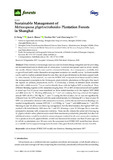Mostrar el registro sencillo del ítem
Sustainable management of metasequoia glyptostroboides plantation forests in Shanghai
| dc.creator | Zheng, Ji | es_ES |
| dc.creator | Blanco Vaca, Juan Antonio | es_ES |
| dc.creator | Wei, Xiaohua | es_ES |
| dc.creator | Liu, Chunjiang | es_ES |
| dc.date.accessioned | 2018-01-27T08:04:27Z | |
| dc.date.available | 2018-01-27T08:04:27Z | |
| dc.date.issued | 2018 | |
| dc.identifier.issn | 1999-4907 (Print) | |
| dc.identifier.issn | 1999-4907 (Electronic) | |
| dc.identifier.uri | https://hdl.handle.net/2454/26948 | |
| dc.description | Incluye material complementario | es_ES |
| dc.description.abstract | Urban forestry is increasingly used as a tool for climate change mitigation and for providing environmental services to inhabitants of urban areas. However, tree species used in urban forestry are usually different from the ones used in commercial forestry. As a consequence, available data on growth and yield under alternative management scenarios are usually scarce. As forest models can be used to explore potential forest futures, they are of special interest as decision-support tools in urban forestry. In this research, we used the FORECAST ecosystem-level forest model to define the management prescriptions for Metasequoia glyptostroboides plantations in Shanghai that reach the highest net primary productivity (NPP). In a first step, a battery of different stand densities (from 500 to 4000 stems ha−1) was used to identify those with the highest NPP at stand level. Then, different thinning regimes (with intensities ranging from 15% to 40% of trees removed and applied at stand age 5 to 20 years) were simulated on those initial densities with the highest NPP (3000 and 4000 stems ha−1). Planting 4000 stems ha−1 and not applying thinning achieved the highest annual NPP (14.39 ± 3.92 Mg ha−1 year−1) during the first rotation, but it was not significantly different from the NPP achieved with the same initial density but thinning 40% of trees at year 10. NPP was estimated to decrease with consecutive rotations, and for the second rotation thinning was needed to significantly increase NPP (10.11 ± 2.59 Mg ha−1 year−1 with 4000 stems ha−1 and 25% thinning at year 10) above non-thinning management. For the third rotation, the highest NPP was reached with initial density 3000 stems ha−1 and 25% thinning at year 10. Nitrogen flows were also estimated to decrease with consecutive rotations. These results indicate the potential of managing M. glyptostroboides urban plantations to reach their maximum productivity potential, but also that additional actions would be needed to ensure adequate nutrient levels over consecutive rotations. For a species such as M. glyptostroboides, which was discovered for science less than 70 years ago and for which no plantations over 50 years exist, the ecosystem-level FORECAST model has been shown as a suitable tool to support management decision when growth and yield data are not available. | en |
| dc.description.sponsorship | This work is supported by the National Key R&D Program of China (2017YFC0505501), the National Natural Science Foundation of China (Grant No. 31400605), CFERN & BEIJING TECHNO SOLUTIONS Award Funds on excellent academic achievements, Shanghai Landscaping & City Appearance Administrative Bureau (G171206). Juan A. Blanco was funded through a Ramón y Cajal contract (ref. RYC-2011-08082) and a Marie Curie Action (ref CIG-2012-326718-ECOPYREN3). | en |
| dc.format.mimetype | application/pdf | en |
| dc.language.iso | eng | en |
| dc.publisher | MDPI | en |
| dc.relation.ispartof | Forests 2018, 9 (2), 64 | en |
| dc.rights | © 2018 by the authors. Licensee MDPI, Basel, Switzerland. This article is an open access article distributed under the terms and conditions of the Creative Commons Attribution (CC BY) license. | en |
| dc.rights.uri | http://creativecommons.org/licenses/by/4.0/ | |
| dc.subject | Urban forest | en |
| dc.subject | FORECAST model | en |
| dc.subject | Tree densities | en |
| dc.subject | Thinning treatment | en |
| dc.subject | NPP | en |
| dc.title | Sustainable management of metasequoia glyptostroboides plantation forests in Shanghai | en |
| dc.type | Artículo / Artikulua | es |
| dc.type | info:eu-repo/semantics/article | en |
| dc.contributor.department | Ciencias del Medio Natural | es_ES |
| dc.contributor.department | Natura Ingurunearen Zientziak | eu |
| dc.rights.accessRights | Acceso abierto / Sarbide irekia | es |
| dc.rights.accessRights | info:eu-repo/semantics/openAccess | en |
| dc.identifier.doi | 10.3390/f9020064 | |
| dc.relation.projectID | info:eu-repo/grantAgreement/European Commission/FP7/326718 | en |
| dc.relation.publisherversion | https://dx.doi.org/10.3390/f9020064 | |
| dc.relation.publisherversion | http://www.mdpi.com/1999-4907/9/2/64/s1 | |
| dc.type.version | Versión publicada / Argitaratu den bertsioa | es |
| dc.type.version | info:eu-repo/semantics/publishedVersion | en |



